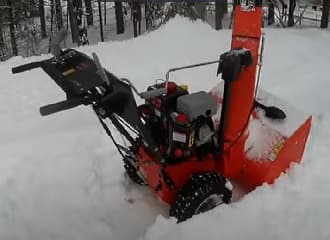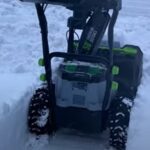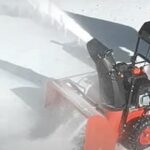As an Amazon Associate, this site earns commissions from qualifying purchases. For more information click here.
Is your snow blower no longer running as smoothly as before? Does the engine sound rough or stall when you try to move forward? If your snow blower is not moving efficiently, there is something in the engine or fuel that needs attention. This post explains what you have to do.
The most common reason why a snow blower runs rough is a clogged carburetor, which can be fixed with a rebuild kit or a new carburetor. Other reasons are a faulty spark plug or a worn out fuel filter, both of which are replaceable.
Engine Fuel Issues
If your snow blower is having difficulty running, it could be related to fuel. The most likely problems that can affect snow blower performance are:
- Too much or too little fuel
- Fuel is too rich or too lean
- Old fuel left in the tank
Too much or too little fuel. A snow blower like the 2-stage PowerSmart 212cc needs the right amount of fuel to run. Too little and the engine is under powered. Too much and the excess fuel gets deposited on the spark plug and other components.
Follow the manual instructions on how much fuel to add. Make sure the carburetor is clean so it can do the proper air and fuel mix. This also prevents the fuel from being too rich or too lean.
Old fuel. Replace the fuel every 30 days. Do not leave it there any longer because it will turn gummy and clog the engine.
Replace the Spark Plug
The spark plug produces the spark which leads to fuel ignition, allowing the engine to start. If there are carbon or fuel deposits on the spark plug, it will not function.
Oil and carbon deposits have many causes, including a fuel mix that is too rich, damaged ignition module, idling too long or a clogged carburetor. Worn out piston rings or too much fuel leads to oil deposits on the spark plug.
How to Replace a Snow Blower Spark Plug
Tools and Materials
- New spark plug
- Ratchet
- Hammer
- Socket compatible with the spark plug
- Gap gauge tool (the CTA Tools 3235 Spark Plug Gapper is very easy to use
Steps
- Detach the spark plug wire. Use a ratchet and socket to detach the spark plug off the cylinder.
- Put the gap gauge tool between the spark plug electrodes. The tool should be a good fit and have minimal resistance when you take it out.
- If the gap is too small, widen it with the gap gauge bender. If the gap is too wide, use a hammer or similar tool to tap it. Do this lightly to avoid damage.
- Get your new spark plug and thread it into the cylinder. Tighten the plug. Use the socket and wrench to turn the spark plug by another half or one fourth turn.
- Reattach the spark plug wire and you are done.
Rebuild or Replace the Carburetor
The carburetor mixes the fuel and air, so if there is a problem here the engine will not run. If the carburetor is clogged, you have two options: clean and rebuild or replace it.
Should You Rebuild or Replace a Carburetor? It is easier to replace a carburetor than rebuild it. There are carburetor rebuild kits available, but you have to make sure it is compatible with your snow blower. If you have an Ariens for instance, the kit you buy must be designed for it.
If you are knowledgeable about carburetors, rebuilding is a good choice. Rebuild kits include gaskets, seals, jets and other parts you will need.
This video demonstrates how to rebuild a snow blower carburetor.
If you are not into DIY or don’t want to take the thing apart, just buy a replacement. There are replacement carburetors for all popular snow blower models so it won’t be hard finding one.
Before you rebuild the carburetor, clean it thoroughly. Clogging is a common problem so don’t be surprised if you see it filled with deposits. Wipe off the grime and replace any worn out or damaged parts with your rebuild kit.
Clogged Tires
If there is too much ice and snow, the tires could get clogged or punctured by an object in the ground.
If you are dealing with a lot of material, adding tire chains to your snow blower will make navigation easier.
Always check the tires before and after use. Also inspect the rest of the snow blower for signs of clogging elsewhere. Make sure the snow blower has enough power to handle the snow you are facing. For anything deeper than 8 inches, a dual stage snow blower is required.
Adjust the Valve Lash
The valve lash is the space between the valve stem top and the rocker arm. This is the point when the piston is at the height of its movement in the engine.
The valve needs to be closed when the piston is at the peak. If the valve lash is not functioning correctly, your snow blower will run rough and be difficult to start. Even if the engine runs, it will be below normal power levels.
Check the valve slash on your snow blower every 90-100 hours. This video demonstrates how to adjust the valve slash.
Defective Fuel Filter
The fuel filter prevents particles and contaminants from reaching the fuel tank. If the filter is clogged it will not function properly. The solution is to replace the fuel filter as soon as possible.
The following guide is applicable for all snow blowers that have the fuel filter at the bottom of the fuel reservoir. Replace the fuel filter at the start of each season for the best results.
Tools and Materials
- New fuel filter
- Socket and wrenches
- Needle nose pliers
- Slot screwdriver
- Philips screwdriver
- Safety goggles
- Gloves
Steps
- Shut the snow blower down and allow the engine to cool off.
- Empty the fuel tank.
- Disconnect the spark plug wire.
- Take off the mounting screws off the electric starter and let it dangle on the cord.
- Take off the key, throttle and choke knobs and the carburetor engine nuts.
- Remove the screws on the muffler shroud and take the engine shroud off. Keep the breather and primer hoses in place.
- Take out the fuel filter and install the new one. Check your owner’s manual for any specific steps that may have to be taken.
- Once the fuel filter is on, reattach the fuel line.
- Put the engine shroud back on. Depending on the snow blower, you might have to take the muffler shroud off first.
- Put the other parts you removed back on, in the exact order which you took them out.

How to Prevent Snow Blower Engine Problems
Regular maintenance is the key to minimizing engine and other performance issues. The following are some of the steps you should take whenever you clean up or inspect your snow blower.
Clean the snow blower regularly. Remove all clogging. Wipe the snow and ice off. Store the snow blower in a safe place when not in use. These are simple but effective ways to prolong its life.
Some more reminders:
- Replace the spark plug every season or every 100 hours. If the spark plug is defective, replace it right away.
- Clean the air filters regularly. If the filter is too dirty or damaged, replace it.
- Check the carburetor regularly. It is an integral part of small engines.
- Replace the oil every 30 days. If you are using a 4-stroke snow blower, do not mix gas and oil.
- Inspect the shear pins if you put them on. These and other fasteners might come loose and affect performance.
- Just like other small engines, snow blowers benefit from lubrication. Check your owner’s manual for specific instructions on how to lubricate the machine and how often.
- Check the tire pressure before you use the snow blower. It has to be at the right level.
Finally, if you installed skid shoes, check if they are still in place. Adjust them if needed or replace if there is damage.

I love the outdoors and all the tools for maintaining gardens, yards and lawns. The only thing I am more passionate about is sharing what I know about garden and outdoor equipment.


